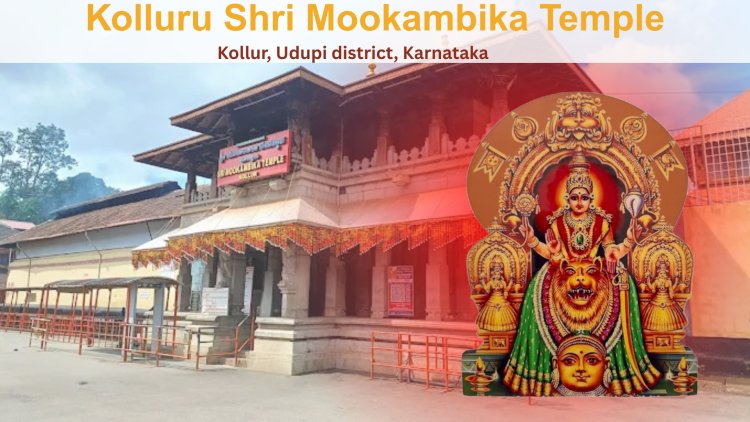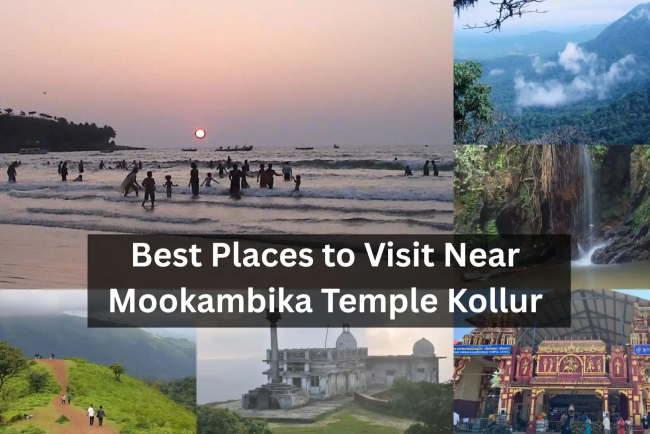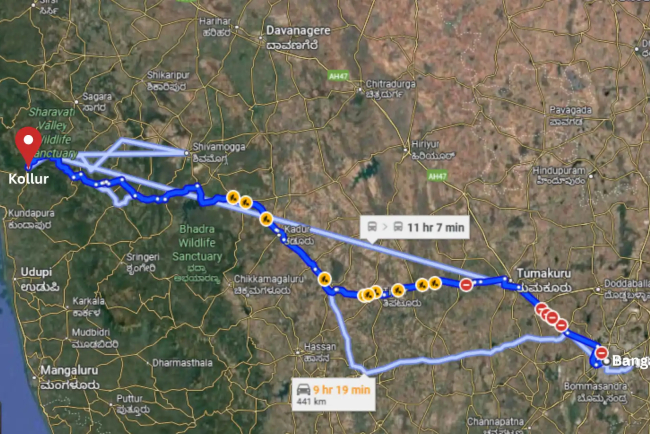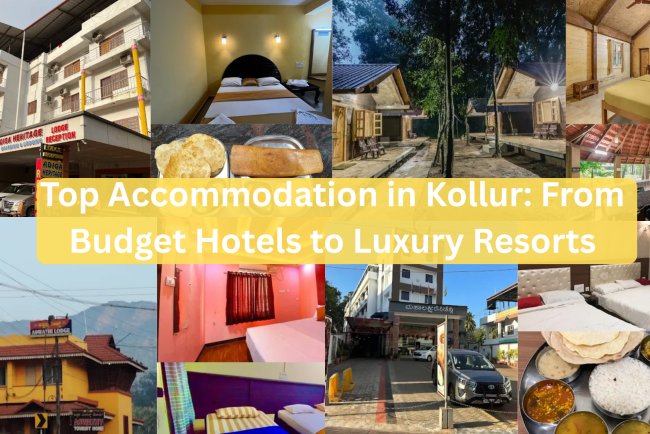A Complete Guide to Kollur Mookambika Temple: History, Timings & Darshan
Explore Kollur Mookambika Temple’s history, darshan timings, sevas, dress code, and travel guide for devotees visiting this holy shrine.

Nestled in the Western Ghats of Karnataka, the Kollur Mookambika Temple is one of South India’s most revered Shakti shrines. Pilgrims from across India come seeking blessings for learning, health, and prosperity, believing the Devi here embodies Saraswati, Lakshmi, and Parvati in one form. The temple’s powerful darshan, age-old rituals, and serene riverside setting make Kollur a sacred destination for families, students, and devotees planning a meaningful pilgrimage. For many, Kollur marks life’s milestones from a child’s first letters to vows for success under the Mother’s grace.
History of Kollur Mookambika Temple
For centuries, Kollur Mookambika Temple has been a foremost Shakti kshetra of coastal Karnataka. Tradition holds that the Mother Goddess revealed her power here to safeguard sages meditating on nearby Kodachadri. The shrine’s renown deepened when Adi Shankaracharya systematised worship and installed the idol of Devi, harmonising devotion with Advaita. Successive patrons and devotees expanded the precincts, preserving Vedic rites, daily annadanam, and the distinctive worship of the swayambhu Jyotirlinga, marked by a golden line signifying the inseparable unity of Shiva and Shakti.
Divine Significance
Kaumasura’s penance threatened dharma, the Goddess made him mute, ending his boon, and then destroyed him. Sri Adi Shankaracharya is believed to have consecrated the panchaloha idol here, aligning the cult of Devi with Advaita and establishing Kollur as a major Shakti kshetra.
Legends of Goddess Mookambika
The name “Mookambika” comes from the slaying of the demon Mookasura, rendered speechless (mooka) by the Goddess before his defeat. Devotees revere the Devi as the union of Shiva and Shakti, bestowing learning, prosperity, and protection in a single compassionate form.
Architectural Highlights
Built in a Kerala-influenced style with copper roofs and deepasthambha, the sanctum enshrines a swayambhu Jyotirlinga marked by a golden line signifying Shiva–Shakti unity. Around it stand sub-shrines, carved woodwork, and lamps that preserve the temple’s serene, ancient aura.
Location of Kollur Temple
Located in the Udupi district of coastal Karnataka, Kollur lies at the foothills of Kodachadri in the Western Ghats, on the banks of the sacred Souparnika River. The shrine is revered as a powerful Shakti kshetra widely regarded by devotees as a Shakti Peetha, drawing pilgrims from Karnataka, Kerala, and beyond.
How to Reach Kollur Mookambika Temple
Kollur is well-connected by road along the coastal NH66 corridor, with easy last-mile access from Kundapura and Byndoor. Pilgrims typically combine train or air travel to the Konkan/Mangaluru hubs and then continue by bus or cab to the temple town.
By Road
· Udupi → Kollur: 74–80 km via NH66 (Udupi → Kundapura) and SH52/NH169A (Kundapura → Vandse → Kollur), travel time: 2–2.5 hours depending on ghat traffic.
· Buses: Frequent KSRTC and private buses from Udupi/Kundapura to Kollur (early morning to late evening).
· Cabs/Self-drive: Taxis are readily available in Udupi/Kundapura. The roads are scenic but curvy near the ghats. Drive cautiously in the rain.
· Other feeders: Mangaluru → Kollur ~130–140 km (3.5–4.5 hours) via NH66; Byndoor (Murudeshwar side) → Kollur ~28–32 km (45–60 minutes).
By Train
· Nearest stations: Byndoor (Mookambika Road–BYNR) 28–32 km, Kundapura (KUDA) 38–40 km, Udupi (UD) 74–80 km.
· Connectivity: Konkan Railway trains connect Mangaluru, Udupi, Goa, Mumbai, and beyond. Alight at BYNR/Kundapura, then take a bus or taxi to Kollur.
· From Mangalore: Take a train to Kundapura/Byndoor (1.5–2.5 hours), then transfer by road (45–60 minutes) to the temple.
By Air
· Nearest airport: Mangalore International Airport (IXE) 130 km from Kollur; typical road transfer 3–4 hours via NH66.
· Transfers: Airport taxis are available; alternatively, a bus service is available to Kundapura/Udupi, with onward connections to Kollur.
Local Transport Options
Auto-rickshaws, local taxis, and town buses operate within Kollur and to nearby hubs (Vandse/Kundapura/Byndoor). Jeeps are also commonly hired for the Kodachadri route. Start early and check the weather in monsoon months.
Kollur Mookambika Temple Timings
The temple follows a precise daily schedule with multiple darshan windows and ritual intervals. On festival/special days, evening timings may change; check notices at the temple or the official site.
Daily Opening & Closing Hours
· Opens: 5:00 AM; morning darshan is typically held from 5:00 to 7:15 AM and from 7:45 to 11:30 AM. Limited noon darshan is available from 12:00–12:20 PM and 12:45–1:30 PM; the mid-day closure is at 1:30 PM.
· Reopens: 3:00 PM; darshan 3:00–6:30 PM (darshan-only from 3:00–5:00 PM; sevas are paused).
· Evening & night: Pradosha pooja around 6:30 PM; Naivedya ~7:00 PM; Mangalarathi 7:15–7:30 PM. Darshan generally takes place from 5:00–9:00 PM (except on special days), final rituals occur from 8:00–8:30 PM, and the temple closes around 9:00 PM.
Darshan & Sevas at the Temple
The temple offers orderly darshan throughout the day, with clear queues and a well-run seva system. Devotees can choose between general and special entry, and book specific poojas that align with their intentions, such as learning, health, prosperity, or thanksgiving.
Types of Darshan
· General darshan: Free, stand in the standard queue during the open slots, ideal for most pilgrims.
· Special/VIP entry: Paid queue with shorter waiting time on busy days, available at counters and during select hours.
· Senior citizens & differently-abled individuals: Assisted entry is usually facilitated by temple staff. Please carry a valid ID and request assistance at the office.
· Group/Family darshan: Families performing a booked seva are guided to the sanctum at the designated time.
· Peak days: During Navratri and festival nights, expect longer queues and security checks. Arrive early to avoid delays.
Popular Sevas and Poojas
· Chandika Homa: A powerful fire ritual seeking the removal of obstacles and protection performed by Vedic priests with sankalpa in the devotee’s name.
· Udayasthamana Pooja: Continuous worship from morning to evening on a chosen day, families sponsor the whole day's pujas for blessings of health and prosperity.
· Tulabhara Seva: Offering items (often grains, jaggery, or coconuts) equal to one's body weight as gratitude; receipts are issued, and prasadam is provided.
· Lalitha Sahasranama Archana: Recital of the thousand names of the Divine Mother with kumkum archana for harmony, peace, and success.
· Saraswati Pooja: Especially popular with students and artists; seeks knowledge, clarity of thought, and excellence in studies and music.
Online & Offline Booking Process
· Online: Use the official temple seva portal to check availability, select date/time, enter devotee details, and pay the fee. Carry the e-receipt and a valid ID.
· Offline: Counters at the temple office issue tokens/receipts for same-day or next-day sevas, subject to slots.
· Reporting: Arrive 30–45 minutes before the scheduled seva with your receipt; staff will guide you to the designated queue.
· Notes: Seva timings may change on festival days. Reschedule and refund rules are as per the temple policy displayed at the counters.
Dress Code & Temple Rules

The temple encourages modest, traditional dress. Men: dhoti/veshti or full-length trousers with a shirt, avoid shorts or sleeveless wear. Women: saree, salwar-kameez, or other modest Indian attire, carry a shawl/dupatta for the sanctum.
Prohibited/limited items: Leather articles inside inner precincts, smoking/tobacco, alcohol, and littering. Please switch your mobiles to silent mode. Photography and videography are not permitted inside the sanctum and are restricted elsewhere, as indicated by signage and staff instructions.
Darshan & prasadam guidelines: Join the marked queues, keep to the right, and maintain silence. Offerings should be handed over only at the designated counters. Please do not cross the protective rails. Follow the priest's direction during archana. Collect prasadam at the counters using your seva/receipt, one set per ticket. Respect separate lines for women/seniors when available, and exit promptly to ease crowd flow.
Facilities for Devotees
The temple supports pilgrims with simple, reliable facilities, free meals, clean lodging options, safe parking, and basic amenities so families, students, and elders can focus on darshan without logistical stress.
Annadanam (Free Meals)
Daily sattvic meals are typically served at noon in the community dining hall. Collect a free token near the entrance, join the queue, wash your hands at the taps, and take a seat in the designated rows; volunteers serve on banana leaves. Usual serving window is around 12:15–2:30 PM (extended on peak days). Children and seniors are given priority; please avoid food waste and return your plates to the designated bins.
Accommodation Options
Temple-managed guest houses located near the main entrance offer basic, budget-friendly rooms and family suites, complete with clean bedding and hot water. Bookings are made at the Devasthanam office (ID required). Please reserve early during Navratri and long weekends. Check-in/out is typically 24 hours from the time of allotment. Private hotels and lodges are also available across Kollur, with additional choices at Byndoor and Kundapura.
Parking & Other Amenities
Marked parking lots for two-wheelers, cars, and buses are located near the bus stand/approach road; fees are nominal, and receipts are issued. Filtered drinking water points and public restrooms are maintained throughout the complex. You'll find a cloakroom and footwear stands, prasadam and pooja item counters, ATMs/first-aid nearby, along with clear signage for queues and exits.
Festivals Celebrated at Kollur Mookambika Temple
The temple’s festival calendar follows the lunar cycle, with peak celebrations that draw devotees from across South India and the Konkan.
Navratri (Sharannavaratri): Nine nights of Devi worship with daily alankaras, special Chandika Homas, Lalitha Sahasranama, and suvasini/kanya pooja. Cultural programs and extended darshan hours culminate in Mahanavami and Vijayadashami, when many families perform Vidyarambham/Aksharabhyasa for children.
Annual Rathotsava: A multi-day celebration featuring Dwajarohana (flag hoisting), grand chariot processions around the temple streets, Vedic chanting, and community participation as devotees pull the decorated rathas seeking the Mother’s blessings.
Other major poojas & cultural events include Kartika Deepotsava, featuring rows of lamps, Makara Sankranti poojas, special abhishekas on auspicious Fridays, Pournami/Amavasya homas, and seasonal Lalitha Sahasranama and Saraswati poojas. Music, bhajans, and Veda-parayana often accompany major observances, enhancing the temple’s devotional atmosphere for pilgrims and families.
Nearby Attractions Around Kollur
Souparnika River: A sacred stream skirting the temple; devotees take a purifying dip at the ghat before darshan. Tradition holds that the waters flow past the herb-rich foothills of Kodachadri, symbolising inner cleansing and blessings from the Mother.
Kodachadri Hills: A renowned Western Ghats peak associated with Adi Shankaracharya’s meditation spot (Sarvajna Peetha). Pilgrims visit for panoramic views and spiritual serenity; trekkers opt for marked forest trails, while jeeps (operating seasonally) depart from nearby bases for a rugged, scenic ascent.
Travel Tips for Devotees
Travel to Kollur is smoother with a bit of planning. Pick the right season, pack temple-appropriate clothing, and plan for queues on festival days so elders and children remain comfortable throughout the pilgrimage.
Best Time to Visit
October–March is ideal: cooler weather, clear roads, and scenic ghats. April–May can be warm; start early for darshan. June–September brings heavy monsoon showers, expect slippery ghats, occasional delays, and larger crowds on weekends. For a calmer experience, consider weekdays and non-festival dates, and arrive at dawn to avoid shorter queues.
Things to Carry
Traditional attire (saree/salwar, dhoti/full-length trousers), a light shawl, and comfortable sandals for quick removal. Pooja items if you've booked a seva (flowers/kumkum as permitted). Refillable water bottle, small umbrella/raincoat for monsoons, and a torch for early starts, medicines, band-aids, and ID cards for seniors; basic cash, as some counters prefer cash.
Safety & Family Travel Tips
Use designated footwear stands, keep a token, or note your rack. Follow barricades and staff instructions, hold children's hands in moving queues. During festivals, allow extra time and use the designated senior entry when available. Avoid river dips during strong currents; check notices before proceeding.
Conclusion
At the Kollur Mookambika Temple, the presence of the Mother is felt in the hush of the sanctum and the flow of the Souparnika River. Devotees come for learning, health, and prosperity and leave with quiet strength. Whether you seek Vidyarambham for a child, a thanksgiving seva, or simple darshan, the Goddess one with Saraswati, Lakshmi, and Parvati blesses sincere effort. Plan your visit, follow temple timings and codes, and experience a pilgrimage that nurtures faith and family. May Her grace guide your studies, work, and well-being.
FAQs
1) What are the darshan timings at Kollur Mookambika Temple?
2) How do I book sevas (online/offline)?
3) Which poojas are recommended for students, prosperity, or obstacle removal?
- Students/learning: Saraswati Pooja, Vidyarambham/Aksharabhyasa (especially on Vijayadashami).
- Prosperity/household wellbeing: Udayasthamana Pooja, Lalitha Sahasranama Archana.
- Protection/obstacles/health: Chandika Homa; gratitude offerings via Tulabhara Seva.
4) Is there a dress code, and what items are restricted?
Avoid shorts, sleeveless tops, and leather inside the inner precincts. Please switch your phones to silent mode; no photography is allowed in the sanctum.
5) What are the nearest railway stations/airport and local transport options?
- Rail: Byndoor (Mookambika Road – 28–32 km), Kundapura (38–40 km), Udupi (74–80 km) on Konkan Railway.
- Air: Mangalore International Airport (IXE, 130 km) with taxis/buses to Kundapura/Byndoor and onward to Kollur.
- Local: autos, taxis, town buses; jeeps commonly hired for Kodachadri route (weather-dependent)
What's Your Reaction?















